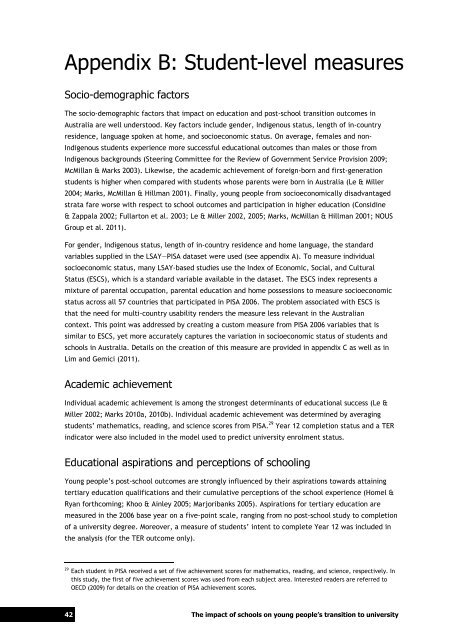The impact of schools on young people's transition to university
The impact of schools on young people's transition to university
The impact of schools on young people's transition to university
You also want an ePaper? Increase the reach of your titles
YUMPU automatically turns print PDFs into web optimized ePapers that Google loves.
Appendix B: Student-level measures<br />
Socio-demographic fac<strong>to</strong>rs<br />
<str<strong>on</strong>g>The</str<strong>on</strong>g> socio-demographic fac<strong>to</strong>rs that <str<strong>on</strong>g>impact</str<strong>on</strong>g> <strong>on</strong> educati<strong>on</strong> and post-school transiti<strong>on</strong> outcomes in<br />
Australia are well unders<strong>to</strong>od. Key fac<strong>to</strong>rs include gender, Indigenous status, length <str<strong>on</strong>g>of</str<strong>on</strong>g> in-country<br />
residence, language spoken at home, and socioec<strong>on</strong>omic status. On average, females and n<strong>on</strong>-<br />
Indigenous students experience more successful educati<strong>on</strong>al outcomes than males or those from<br />
Indigenous backgrounds (Steering Committee for the Review <str<strong>on</strong>g>of</str<strong>on</strong>g> Government Service Provisi<strong>on</strong> 2009;<br />
McMillan & Marks 2003). Likewise, the academic achievement <str<strong>on</strong>g>of</str<strong>on</strong>g> foreign-born and first-generati<strong>on</strong><br />
students is higher when compared with students whose parents were born in Australia (Le & Miller<br />
2004; Marks, McMillan & Hillman 2001). Finally, <strong>young</strong> people from socioec<strong>on</strong>omically disadvantaged<br />
strata fare worse with respect <strong>to</strong> school outcomes and participati<strong>on</strong> in higher educati<strong>on</strong> (C<strong>on</strong>sidine<br />
& Zappala 2002; Fullart<strong>on</strong> et al. 2003; Le & Miller 2002, 2005; Marks, McMillan & Hillman 2001; NOUS<br />
Group et al. 2011).<br />
For gender, Indigenous status, length <str<strong>on</strong>g>of</str<strong>on</strong>g> in-country residence and home language, the standard<br />
variables supplied in the LSAY—PISA dataset were used (see appendix A). To measure individual<br />
socioec<strong>on</strong>omic status, many LSAY-based studies use the Index <str<strong>on</strong>g>of</str<strong>on</strong>g> Ec<strong>on</strong>omic, Social, and Cultural<br />
Status (ESCS), which is a standard variable available in the dataset. <str<strong>on</strong>g>The</str<strong>on</strong>g> ESCS index represents a<br />
mixture <str<strong>on</strong>g>of</str<strong>on</strong>g> parental occupati<strong>on</strong>, parental educati<strong>on</strong> and home possessi<strong>on</strong>s <strong>to</strong> measure socioec<strong>on</strong>omic<br />
status across all 57 countries that participated in PISA 2006. <str<strong>on</strong>g>The</str<strong>on</strong>g> problem associated with ESCS is<br />
that the need for multi-country usability renders the measure less relevant in the Australian<br />
c<strong>on</strong>text. This point was addressed by creating a cus<strong>to</strong>m measure from PISA 2006 variables that is<br />
similar <strong>to</strong> ESCS, yet more accurately captures the variati<strong>on</strong> in socioec<strong>on</strong>omic status <str<strong>on</strong>g>of</str<strong>on</strong>g> students and<br />
<str<strong>on</strong>g>schools</str<strong>on</strong>g> in Australia. Details <strong>on</strong> the creati<strong>on</strong> <str<strong>on</strong>g>of</str<strong>on</strong>g> this measure are provided in appendix C as well as in<br />
Lim and Gemici (2011).<br />
Academic achievement<br />
Individual academic achievement is am<strong>on</strong>g the str<strong>on</strong>gest determinants <str<strong>on</strong>g>of</str<strong>on</strong>g> educati<strong>on</strong>al success (Le &<br />
Miller 2002; Marks 2010a, 2010b). Individual academic achievement was determined by averaging<br />
students’ mathematics, reading, and science scores from PISA. 29 Year 12 completi<strong>on</strong> status and a TER<br />
indica<strong>to</strong>r were also included in the model used <strong>to</strong> predict <strong>university</strong> enrolment status.<br />
Educati<strong>on</strong>al aspirati<strong>on</strong>s and percepti<strong>on</strong>s <str<strong>on</strong>g>of</str<strong>on</strong>g> schooling<br />
Young people’s post-school outcomes are str<strong>on</strong>gly influenced by their aspirati<strong>on</strong>s <strong>to</strong>wards attaining<br />
tertiary educati<strong>on</strong> qualificati<strong>on</strong>s and their cumulative percepti<strong>on</strong>s <str<strong>on</strong>g>of</str<strong>on</strong>g> the school experience (Homel &<br />
Ryan forthcoming; Khoo & Ainley 2005; Marjoribanks 2005). Aspirati<strong>on</strong>s for tertiary educati<strong>on</strong> are<br />
measured in the 2006 base year <strong>on</strong> a five-point scale, ranging from no post-school study <strong>to</strong> completi<strong>on</strong><br />
<str<strong>on</strong>g>of</str<strong>on</strong>g> a <strong>university</strong> degree. Moreover, a measure <str<strong>on</strong>g>of</str<strong>on</strong>g> students’ intent <strong>to</strong> complete Year 12 was included in<br />
the analysis (for the TER outcome <strong>on</strong>ly).<br />
29 Each student in PISA received a set <str<strong>on</strong>g>of</str<strong>on</strong>g> five achievement scores for mathematics, reading, and science, respectively. In<br />
this study, the first <str<strong>on</strong>g>of</str<strong>on</strong>g> five achievement scores was used from each subject area. Interested readers are referred <strong>to</strong><br />
OECD (2009) for details <strong>on</strong> the creati<strong>on</strong> <str<strong>on</strong>g>of</str<strong>on</strong>g> PISA achievement scores.<br />
42 <str<strong>on</strong>g>The</str<strong>on</strong>g> <str<strong>on</strong>g>impact</str<strong>on</strong>g> <str<strong>on</strong>g>of</str<strong>on</strong>g> <str<strong>on</strong>g>schools</str<strong>on</strong>g> <strong>on</strong> <strong>young</strong> people’s transiti<strong>on</strong> <strong>to</strong> <strong>university</strong>


